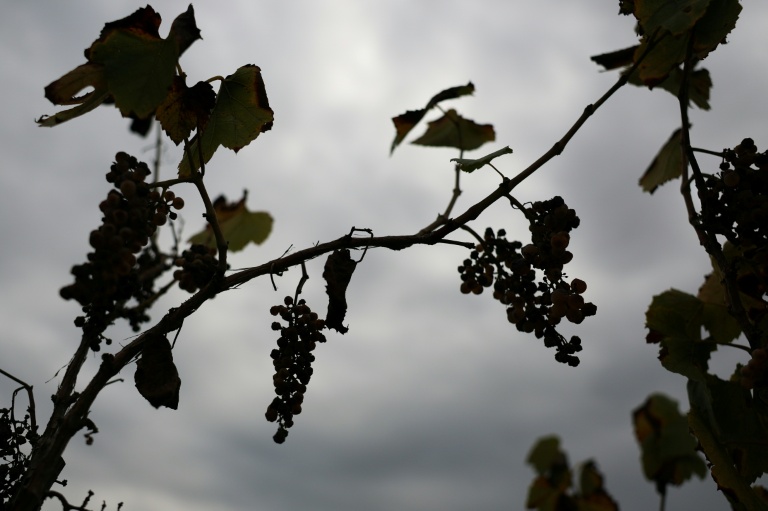Top Stories
California Grape Farmers Abandon Vineyards Amid Crisis

UPDATE: California’s grape industry faces an urgent crisis as local farmers abandon their vineyards due to skyrocketing costs and declining demand. In Lodi, where grape growing has been a tradition for over a century, nearly 25% of the region’s grape production has been uprooted in just two years.
Grape grower Randy Baranek reports that thousands of acres have been removed, reflecting a significant shift in the local economy. “I’ve never seen anything like this,” Baranek told AFP, highlighting the dire situation as he navigated through abandoned Chardonnay vines.
The numbers are alarming: last year, Lodi harvested 2.9 million tons of grapes—the lowest yield in two decades. This year, experts predict a further decline of 400,000 tons, according to Stuart Spencer, executive director of the Lodi Winegrape Commission. The changing landscape of the wine market is attributed to shifting consumer preferences and economic pressures.
“People are just drinking less,” Spencer stated, noting that inflation has squeezed consumer wallets, leading to a downturn in purchases. As a result, big wineries are opting for cheaper imports instead of sourcing grapes locally, which has sent shockwaves through the industry.
Farmers are now considering alternatives, with many reluctantly shifting from grapes to more lucrative crops like almonds. While converting grape fields can cost tens of thousands of dollars, almond farming offers lower expenses and a straightforward market. “With wine grapes, you’ve really got to go out there and you’ve got to talk to wineries,” said Kevin Phillips, a grower who transitioned his vineyard to almonds. “Almonds, you don’t have to talk to anybody. There’s just a demand.”
The human impact of this crisis is palpable. Workers who have relied on vineyard jobs for years are worried about their future. “There’s no other talk on the streets; we’re all very worried,” shared a worker with a decade of experience in the vineyards. The shift not only threatens livelihoods but also changes the agricultural landscape in Lodi, impacting local communities.
As the situation unfolds, farmers face tough decisions. The shift to almonds not only alters the types of crops grown but also reduces labor needs, as almond harvesting is largely automated. The community is bracing for a future where vineyards may become relics of the past.
The Lodi grape industry’s struggles are a microcosm of broader trends affecting American agriculture. As the market continues to evolve, stakeholders will need to adapt quickly to survive in an increasingly competitive landscape.
WHAT’S NEXT: Farmers and officials are closely monitoring the market for signs of recovery. With consumer tastes shifting and economic conditions fluctuating, the future of Lodi’s vineyards hangs in the balance. The local community remains on edge, watching to see how these changes will reshape their way of life.
-

 Politics4 weeks ago
Politics4 weeks agoSecwepemc First Nation Seeks Aboriginal Title Over Kamloops Area
-

 World5 months ago
World5 months agoScientists Unearth Ancient Antarctic Ice to Unlock Climate Secrets
-

 Entertainment5 months ago
Entertainment5 months agoTrump and McCormick to Announce $70 Billion Energy Investments
-

 Science5 months ago
Science5 months agoFour Astronauts Return to Earth After International Space Station Mission
-

 Lifestyle5 months ago
Lifestyle5 months agoTransLink Launches Food Truck Program to Boost Revenue in Vancouver
-

 Technology3 months ago
Technology3 months agoApple Notes Enhances Functionality with Markdown Support in macOS 26
-

 Lifestyle3 months ago
Lifestyle3 months agoManitoba’s Burger Champion Shines Again Amid Dining Innovations
-

 Top Stories2 months ago
Top Stories2 months agoUrgent Update: Fatal Crash on Highway 99 Claims Life of Pitt Meadows Man
-

 Politics4 months ago
Politics4 months agoUkrainian Tennis Star Elina Svitolina Faces Death Threats Online
-

 Sports5 months ago
Sports5 months agoSearch Underway for Missing Hunter Amid Hokkaido Bear Emergency
-

 Politics5 months ago
Politics5 months agoCarney Engages First Nations Leaders at Development Law Summit
-

 Technology5 months ago
Technology5 months agoFrosthaven Launches Early Access on July 31, 2025





















